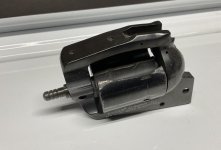Couple of items from above. While Alliant only lists maximum loads, I've noticed that their data seems to (at least in my guns) matches factory ammo. Yes, working up to it is a good idea. Differences in bullet construction and case capacity can rear their ugle heads. Be wary when changing any component......unless maybe when you're working in the middle of the load data.
I recently got a lesson on case capacity between LC Match and Federal Gold Medal Match. And this was a time when Federal ran LC.
One of the things I like best about the various manuals, is when they list powder charges in 100 f/s intervals you can get a grasp on what kind of changes to expect for a given charge weight.....until you get up near the top velocities.
I found the best discussion of determining overpressure in a Sierra manual. The hitch is that it is for loads in NEW brass, not once (or more) fired. For rifle cartridges, you mike the unfired case body just forward of the extractor groove & above the case head. You then mike the same area after firing. Diameter of the case web should not increase more than 0.0005 inches.
I think that method of pressure measurement has been largely dispelled in the last twenty years or so because of differences in brass hardness, metallurgy, and maybe a few other reasons. I don't think the method is totally without merit, just mostly. Those last few words are my opinion only, not necessarily something factual.
I've been intrigued by all this for a while, but I'd been handloading a long time before I did any semi-serious experimentation. I'm sure others have tried the same thing, but here's how I did it...
I was curious about pressure levels with the 7x61 Sharpe & Hart Magnum cartridge about ten or so years years ago. Virtually all of the available data was old and not pressure tested. I had worked with the cartridge in a New Ultra Light Arms rifle enough to know that some of the old published data was potentially dangerous.
I took new Norma factory ammo, fired it in my rifle and measured just ahead of the web. (I'd have to look up my old notes as I can't remember if I took measurements on the belt, just ahead of the belt or both.) With other ammo, I removed the factory bullet, discarded the powder, and loaded my selected bullet and powder leaving the primer Norma used in place.
Bullet and powder were the changeable factors; same brass, same primer. I fired these loads and took measurements on the cases. I believe this is a much better and more accurate method of measuring pressure than the more common method, but again, that is only my opinion. My method is probably not without faults.
I don't know where the arbitrary "don't exceed .0005" expansion" came from. Maybe someone here knows. There is also the "pressure ring" method of measurement described by Ken Waters in his PET LOADS book. Easy to do, but likely not very useful information in most instances.
All this is akin to reading pressure from primer appearance. I think there is limited usefulness in all this stuff I've mentioned, but how far does that usefulness go? Again, only my opinion.
As gunwriter John Barsness has stated many times, chronograph figures may be the most useful way for most of us to determine safe pressure, but this is far from a beginner's project.


